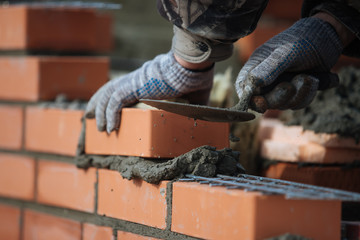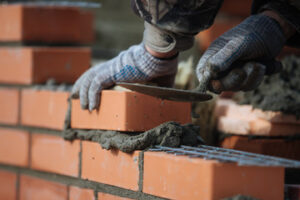
What Is Brick Masonry?
Brick Masonry Charleston SC provides greater structural stability and insulation for your home or business. Properties constructed with masonry materials cost less to heat and cool. Wet bricks a few hours before work to avoid absorption of too much water in a mortar and improve adherence. This will also cut down on cleanup and cleaning costs later.
 Brick masonry involves placing and arranging bricks systematically to produce solid loads that can withstand pressure. It is an important construction material that is commonly used in a variety of architectural masterpieces across the globe. Many different types of bricks can be used in the process, and various steps must be followed to ensure the integrity of a structure.
Brick masonry involves placing and arranging bricks systematically to produce solid loads that can withstand pressure. It is an important construction material that is commonly used in a variety of architectural masterpieces across the globe. Many different types of bricks can be used in the process, and various steps must be followed to ensure the integrity of a structure.
In brick masonry, bricks are glued together using mortar. It is essential to use the correct mortar in order to achieve the desired strength and durability of the structure. The type of brick that is chosen depends on the intended purpose of the building, and a wide range of colors and shapes are available. The most common types of bricks include terra-cotta, concrete, and clay. Masonry may also use other materials such as stone and block.
A brick is a rectangular block of clay that has been hardened by drying in the sun or firing in a kiln. It is a popular building material that has been in use for over 6,000 years. Bricks were originally shaped by hand, but around 4,000 BC, manufacturers began to use uniform molds. This changed the way bricks were constructed, and it greatly improved their durability.
The first step in making a brick is to mix the clay with water and then press it into the molds. The bricks are then left to dry in the sun, which takes approximately two days. Then they are fired in a kiln, which takes up to 24 hours. Depending on the type of brick, the temperature during firing will affect its color and texture.
There are several types of bonds that can be used in brick masonry. One of the most common is header bond, which utilizes a smaller square face of the brick to create a pattern. This is the opposite of stretcher bond, which uses a larger face of the brick to make the pattern.
The first course of a brick wall is laid with three header bricks, followed by stretchers. The header bricks should be spaced evenly, and the mortar joints should be kept at a minimum of 10 mm. It is also important to make sure that the bricks are positioned correctly and that they are leveled. This can be accomplished by frequently checking with a plumb bob.
Mortar
Many people focus on the bricks or stones when they think of masonry work, but mortar is an important part of getting beautiful, lasting results. Mortar acts as the binding material for brick and stone walls, fireplaces, and more, and it’s not something you want to skimp on. Incorrect use of mortar can degrade a brick and stone wall, patio, or fireplace over time, making the initial investment less worthwhile.
Before a mason mixes mortar, they’ll need to dampen the area where it will be placed. Then they’ll mix in the proper ratio of water, cement, and lime. The mortar mix must be liquid enough to spread across brick lines, but thick enough to shape and mold. The mason will then apply the mortar with a trowel to create clean, even layers.
Different types of mortar are used depending on the project at hand, with Type S, N, M, and O being the most common. Each mortar is characterized by its compressive strength, flexibility, and bonding properties. Contractors may choose the right type of mortar based on factors like current project conditions, masonry materials, loading conditions, and weather exposure.
When mixing mortar, it must be done quickly and thoroughly. Mortar is most effective when it’s mixed with a high water-to-cement ratio, and it must remain fluid for an hour or more. Adding too much water can weaken the mortar’s structure, while adding too little makes it hard to work with.
During cold weather, it’s important to take special care with handling, brick-laying, and curing techniques. In addition, masons need to know the appropriate handling, mixing, and curing temperatures for each mortar mixture they use.
Masonry cement is a blend of cement and fine aggregate, usually sand, that’s used as a binding material when working with brick, block, or stone. It’s a different product from concrete, which combines cement with coarse aggregate such as gravel. Masonry cement is available pre-blended to reduce the need for consistent field batching and to meet performance requirements set by ASTM C 91. It’s also an excellent choice for repointing mass masonry structures, such as historical brick buildings.
Joints
There are several types of joints used in brick masonry construction. Some are more effective at preventing water penetration than others. The tried-and-true concave mortar joint is the most popular and durable, while other styles are more specialized and may be used for specific architectural appearances or to accommodate volume changes in masonry units.
The struck mortar joint is a good choice for interior walls because it allows the upper edges of the bricks to be finished flush with the mortar edge. However, it is not suitable for exterior masonry because the lower edge of the strike joint is recessed and can allow water to sit in the cores and penetrate the wall.
This type of mortar joint is tooled with a tool that has a curved shape and creates a v-shaped groove in the face of the brick. This groove prevents water from collecting in the joints and helps prevent mortar erosion. It must be tooled properly so that the surface of the mortar is not weakened by the tool, which can cause cracks in the brick.
A raked mortar joint is very effective at preventing water penetration because it creates a tight seal with the brick. It does not, however, provide as much coverage as the concave mortar joint and is therefore susceptible to weather damage. A raked mortar joint that is not tooled correctly can allow water to enter the brick and may cause problems with shrinkage cracks in the wall.
The splayed mortar joint is also effective at preventing water penetration because it creates an “S”-shaped groove in the face of the brick. It does not, however, protect as well as the concave mortar joint because of its weak point at the center of the “S”. The splayed mortar joint is tooled with a tool with a rounded head that creates a splayed groove in the face of the brick.
A cramped mortar joint is reinforced with metal cramps, which are a dovetail-shaped piece of slate or gun metal that is cut into the sides of adjacent stones and then secured with cement. This joint is used in cornices and other sloped masonry projects to prevent unwanted displacement of the stones.
Finish
Brickmasons use a variety of finishing techniques to give the structures they build a neat, uniform appearance. They begin by laying a bed of mortar (a mixture of cement, lime, and sand) with a trowel (a flat, bladed metal tool with a handle). Then they place each brick in the bed, tapping it lightly to set it in place. They may cut bricks with a hammer and chisel to fit around windows, doors, or other openings. After the bricks are laid, they use jointing tools to fill in the mortar joints and finish them with a smooth surface.
Unlike traditional bricks, which are small and round in shape, concrete blocks are rectangular and flat. They are much easier to lay for a wall of a given size and are used in construction projects where speed is critical, such as industrial buildings and garages. Concrete block walls require less mortar than brick and are also a good choice for damp areas, such as basements.
Masonry workers must be able to read and interpret blueprints and plans. They are responsible for calculating the amount of materials needed for each job and laying the bricks or other materials according to the plan. They must also check the straightness and squareness of walls on a regular basis using a plumb bob or spirit level. Brickmasons must also take proper safety precautions and wear personal protective equipment, including hard hats, gloves, and steel-toed boots.
Once the walls are built, they should be left to cure for a period of two or three weeks. After that, they can be finished with a coating of lime mortar or cement mortar. Before starting work, it is recommended that the surface to be finished is slightly dampened with water. This will make it easy to work with the mortar and prevent it from drying out too quickly. A good consistency for the mortar is peanut butter to milkshake or a little thicker, depending on what look you are going for. After mixing the dry mortar, it should be dampened with a sponge and then spread to a thickness of about 12 inch.
